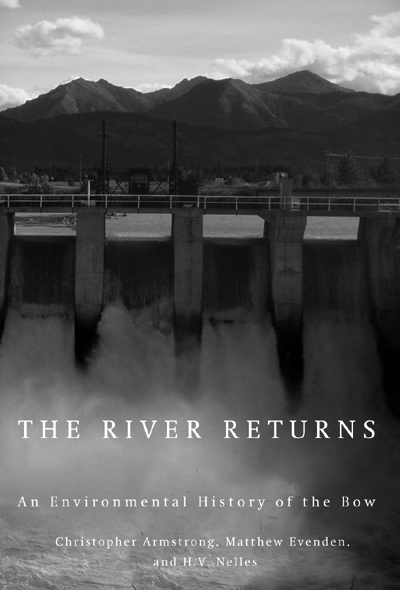Corps de l’article
Environmental history is a vigorous, new area of interest in Canada. Those now practising in the field do so in two senses of that verb: they are limbering up, testing their existing capacities for new challenges, and deploying the skills they have accumulated from previous forays into other fields, retrofitting as they go. This large and beautifully-made book will be a continuing landmark in the terrain we are now exploring, the work of three distinguished scholars who bring to the task prodigious complementary talents and combined energies to do scholarly justice to the many large human and non-human themes emergent in the Bow watershed. They do so with admirable panache, attending tirelessly to the design and prose elements that make the finished volume such an engaging pleasure to the read and to look at.
The book calls to mind two others. Like William Cronon’s Nature’s Metropolis, a monograph on Chicago frequently used as an introductory text in US environmental history courses, The River Returns can serve, as those weighty money-spinning texts of our youth (Robert Rowell Palmer’s The Age of the Democratic Revolution, Donald Creighton’s Dominion of the North and Easterbrook and Aitken’s Canadian Economic History come to mind) as a pedagogical terrain of first encounter. In our post-structuralist time when meta-narratives have been de-centred in favour of thick descriptions of the ‘instance’, the Bow watershed and its patterns of human settlement and resource use can be a model for environmental history students as they are learning what to watch for, and what to do with what they have found. And like Harold Adams Innis’s exposition of the staples paradigm in his studies economic history of the fur trade and the cod fishery, while breaking new ground, these authors situate a distinctively different field of inquiry within reference points students know. As Innis extended and adapted the logic of mercantilist empires, then the dominant paradigm in Canadian historiography, to explore colonial encounters in the North American interior, Armstrong, Evenden and Nelles have turned habits of mind tuned to regulation, business and resource use to follow the frictions and mutualities of the forming human/nature hydrid in a key Canadian intersection.
The Bow is an astute choice, a central force in the human settlement of Alberta, a formative influence in ‘the ways humans with different needs, means, technologies and economies adapted to the challenges and opportunities adapted to the challenges and opportunities of living with a river’ (45). It is also an excellent choice for heuristic purposes, so profoundly do its multiple hydrologies and topographies challenge and confound assumptions founded in instances from a Canadian historiography which has privileged rivers, flowing east or north along shallow gradients, through well-watered lands. What entrepreneurs, engineers, parks planners and agriculturalists understood from previous studies to be the nature of water did not apply to the Bow. This unruly instance confounds, and thus unfolds as a series of barely scrutable conundrums. Why do muskrats thrive, and humans founder in waters remade to serve the needs of arriving human settlers?” Why does the river flood in mid-winter, this story unravelled deftly as a mystery by Nelles, the co-author who grew up in a textile town built on the flood plain at the point where two southern Ontario rivers joined? The alternative plot-lines offered as contending ‘truths’ about the nature of flowing water by reference to the knowledge of professional managers, scientific experts, a suspecting populous and vernacular observers offer an array of splendid ‘teachable’ moments for science studies scholars, the tale motivated by positing and playing out the counter-intuitive resolution: are floods caused by houses?
Before environmental history, it was conventional to frame narratives in landscapes as stable until remade by the works of man. Climate change is altering that now in many settings, and the authors are prescient in charting how telling were the earlier changes made by weather variations in the vulnerable topography of the Bow. Alterations in the rains and the wind remade the valley grades which provided key conduits amongst the shelter, water and stores of winter hay disrupting the life course of the first generation of human settlers and their stock alike.(64) The massive immutability in this narrative, however, was fashioned by entrepreneurs who invested prodigiously in the cement barriers erected early and at great cost, (they did not realize for decades how great), on the erroneous assumption that they were harnessing a river like the rivers they knew, carved primordially through resistant Precambrian shield. The geology of southern Alberta made the Valley of the Bow, flowing through sedimentary foothills, gestational rather than primordial, a landscape of inscrutable risk when the volumes and the location of the run defied the due diligence calculations required for massive run of the river capital investments. Here Armstrong, the team specialist in capital markets, follows the of investors, bound inexorably amidst ricocheting dilemmas created by their ideological commitments to previous investments in the barriers themselves and to the cement plants which provided inputs for both to the dams and to the urban infrastructures growing densely on the nearby floodplains. Path dependence can be dangerous human weakness, and so it was in this case, compounding the downstream follies with destructive reservoirs upstream designed by engineering intrusion to discipline natural variations in the flow of the Bow. Here Evenden takes over and, thinking like a fish, shows how human inclinations to use phosphates to make their homes cleaner and their gardens more lush altered both fish habitat and humans’ recreational and nutritional satisfactions from the fishery.
All in all, this book is a wonderful scholarly achievement but there may be too much of it. Perhaps the authors and their publisher will follow a third scholarly precedent, and like Lawrence Stone, who first published very large studies of the English aristocracy and the European family, will in time favour us who now embody the book through our aching carpal tunnels with a healing abridgement.


